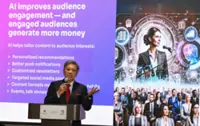A file photo of a girl during online school while her parents work from home and take care of a toddler amid surging Covid-19 cases caused by the coronavirus Omicron variant. Online student monitoring that rose during the pandemic sparks concerns about discrimination and surveillance of marginalised children. — Reuters
WASHINGTON: For New York teacher Michael Flanagan, the pandemic was a crash course in new technology – rushing out laptops to stay-at-home students and shifting hectic school life online.
Students are long back at school, but the technology has lived on, and with it has come a new generation of apps that monitor the pupils online, sometimes round the clock and even on down days shared with family and friends at home.




